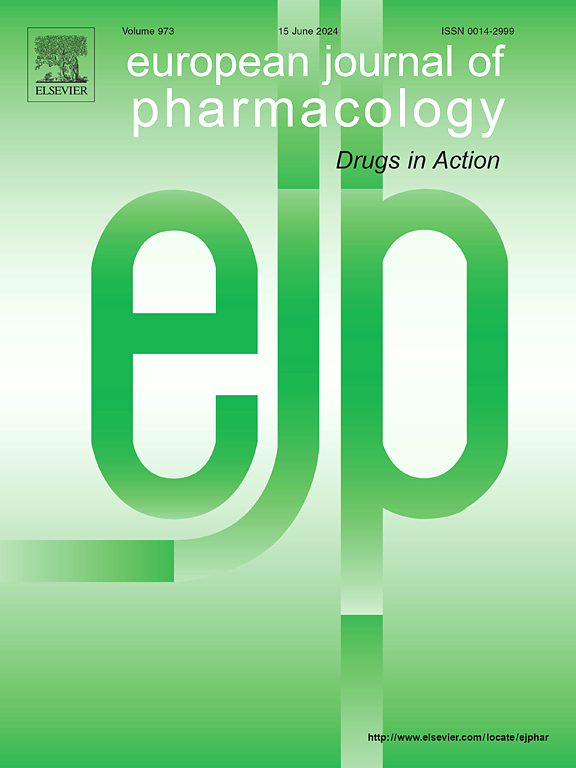慢性间歇性缺氧所致昼夜节律障碍中组胺的神经调节作用
IF 4.2
3区 医学
Q1 PHARMACOLOGY & PHARMACY
引用次数: 0
摘要
阻塞性睡眠呼吸暂停(OSA)的特点是间歇性低氧血症、睡眠片段化和白天过度嗜睡。阻塞性睡眠呼吸暂停患者发生昼夜节律紊乱的风险较高。众所周知,组胺主要通过组胺H1受体调节睡眠-觉醒周期。我们使用暴露于慢性间歇性缺氧(CIH)三周的C57BL/6小鼠模型来评估昼夜节律的变化。对睡眠结构和自主跑轮活动进行评估。此外,还检测了c-fos在额叶皮质(FC)和视交叉上核(SCN)中的表达和mPer2水平。BV-2小胶质细胞被置于间歇性缺氧(IH) 12小时,以探索潜在的信号通路。CIH暴露导致清醒期明显延长,非快速眼动期(NREM)减少,伴随着睡眠碎片增加和昼夜节律中断。用甲醯胺(一种H1受体拮抗剂)治疗可以通过减少觉醒持续时间、延长非快速眼动期和减少睡眠碎片来减轻这些影响。CIH还导致FC和SCN中c-fos表达增加和mPer2水平升高,这两种情况在给药后都被逆转。对BV-2细胞的体外研究表明,组胺通过激活PLC和PKA信号通路发挥其调节作用,通过调节K+、Na + -Ca2+和Ca2+离子通道影响mPer2的表达。总之,CIH通过组胺介导的机制破坏昼夜节律,而甲胺有效地改善了这些破坏。这些发现强调了组胺是解决与OSA相关的昼夜节律障碍的有希望的治疗靶点。本文章由计算机程序翻译,如有差异,请以英文原文为准。
Neuroregulation of histamine of circadian rhythm disorder induced by chronic intermittent hypoxia
Obstructive sleep apnea (OSA) is characterized by intermittent hypoxemia, sleep fragmentation, and excessive daytime sleepiness. OSA patients are at an elevated risk for circadian rhythm disturbances. Histamine is known to regulate the sleep-wake cycle predominantly via histamine H1 receptors. We utilized a C57BL/6 mouse model exposed to chronic intermittent hypoxia (CIH) for three weeks to assess alterations in circadian rhythmicity. Sleep architecture and voluntary wheel-running activity were evaluated. Additionally, c-fos expression and mPer2 levels in the frontal cortex (FC) and the suprachiasmatic nucleus (SCN) were examined. BV-2 microglial cells were subjected to intermittent hypoxia (IH) for 12 h to explore the underlying signaling pathways.
CIH exposure led to a significant prolongation of the wake phase and a reduction in the Non-rapid eye movement (NREM) phase, accompanied by increased sleep fragmentation and disruption of circadian rhythms. Treatment with mepyramine, an H1 receptor antagonist, mitigated these effects by reducing arousal duration, extending NREM phase, and decreasing sleep fragmentation. CIH also resulted in increased c-fos expression and elevated mPer2 levels in the FC and SCN, both of which were reversed following mepyramine administration. In vitro studies on BV-2 cells demonstrated that histamine exerts its modulatory effects through the activation of the PLC and PKA signaling pathways, influencing mPer2 expression via the regulation of K+, Na + -Ca2+, and Ca2+ ion channels.
In conclusion, CIH disrupts circadian rhythms through histamine-mediated mechanisms, and mepyramine effectively ameliorates these disruptions. These findings highlight histamine as a promising therapeutic target for addressing circadian rhythm disorders associated with OSA.
求助全文
通过发布文献求助,成功后即可免费获取论文全文。
去求助
来源期刊
CiteScore
9.00
自引率
0.00%
发文量
572
审稿时长
34 days
期刊介绍:
The European Journal of Pharmacology publishes research papers covering all aspects of experimental pharmacology with focus on the mechanism of action of structurally identified compounds affecting biological systems.
The scope includes:
Behavioural pharmacology
Neuropharmacology and analgesia
Cardiovascular pharmacology
Pulmonary, gastrointestinal and urogenital pharmacology
Endocrine pharmacology
Immunopharmacology and inflammation
Molecular and cellular pharmacology
Regenerative pharmacology
Biologicals and biotherapeutics
Translational pharmacology
Nutriceutical pharmacology.

 求助内容:
求助内容: 应助结果提醒方式:
应助结果提醒方式:


